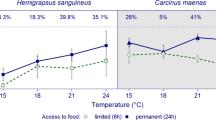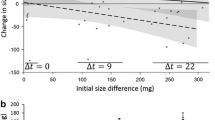Abstract
In the Ria Formosa lagoon (S. Portugal), Carcinus maenas larvae have been observed only during the cold part of the year (October–May), when the water temperature stays below 23 °C. Larvae suffer high mortality during day time (about 80% during 6 h). Hence, they will only develop outside the lagoon, as proved by the observation of zoea I stages exclusively. Main recruitment starts in April, i.e. much later than the first larvae appear. Small crabs prefer Zostera noltii patches and colonize other sites when the carapace width exceeds about 5 mm. A reserve of some small crabs is found in Zostera noltii patches nearly all year round. It is postulated that one of the key factors for successful propagation of the species is a match between physiological reactions (here in particular temperature effect on reproductive cycle and larval release), and the ecological conditions for larval survival and recruitment, such as predator impact, food availability or currents.
Similar content being viewed by others
References
Almaça, C., 1962.Sur la distribution geographique du genre Carcinus Leach (Crustacea: Decapoda, Brachyura). Revista da Faculdade de Ciências da Universidade de Lisboa, 2nd ser. C 10: 109–113.
Bachelet, G., 1987. Processus de recrutement et rôle des stades juvéniles d'invertébrés dans le fonctionnement de systèmes benthiques de substrat meuble en milieu intertidal estuarien. Thèse Doc. Etat Sci. Nat., Univ. Bordeaux I: 478 pp.
Beukema, J. J., 1991. The abundance of shore crabs Carcinus maenas (L.) on a tidal flat in the Wadden Sea after cold and mild winters. J. exp. mar. Biol. Ecol. 153: 97–113.
Cronin, T. W. & R. B. Forward, 1986. Vertical migrations cycles of crab larvae and their role in larval dispersal. Bull. mar. Sci. 39: 192–201.
Cushing, D. H., 1975. Marine Ecology and Fisheries. Cambridge University Press, Cambridge: 278 pp.
Dawirs, R. R., 1985. Temperature and larval development of Carcinus maenas (Decapoda) in the laboratory; predictions of larval dynamics in the sea. Mar. Ecol. Prog. Ser. 24: 297–302.
Dixon, W. J. & A. M. Mood, 1946. The statistical sign test. J. am. Statist. Ass. 41: 557–566.
Drake, P., A. M. Arias & A. Rodríguez, 1998. Seasonal and tidal abundance patterns of decapod crustacean larvae in a shallow inlet (SW Spain). J. Plankton Res. 20: 585–601.
Eriksson, S. & A.-M. Edlund, 1977. On the ecological energetics of 0-group Carcinus maenas (L.) from a shallow sandy bottom in Gullmar Fjord, Sweden. J. exp. mar. Biol. Ecol. 30: 233–248.
Giese, A. C., 1959. Comparative physiology. Annual reproductive cycles of marine invertebrates. Ann. Rev. Physiol. 21: 547–576.
Jackson, D., C. F. Mason & S. P. Long, 1985. Macro-invertebrate populations and production on a salt-marsh in east England dominated by Spartina anglica. Oecologia 65: 406–411.
Klein Breteler, W. C. M., 1976. Settlement, growth and production of the shore crab, Carcinus maenas, on tidal flats in the Dutch Wadden Sea. Neth. J. Sea Res. 10: 354–376.
Mann, H. B. & D. R. Whitney, 1947. On a test of whether one of two random variables is stochastically larger than the other. Ann. Math. Statist. 18: 50–60.
Mohamedeen, H. & R. G. Hartnoll, 1990. Larval and postlarval growth of individually reared specimens of the common shore crab Carcinus maenas (L.). J. exp. mar. Biol. Ecol. 134: 1–24.
Moksnes, P.-O., L. Pihl & J. van Montfrans, 1998. Predation on postlarvae and juveniles of the shore crab Carcinus maenas: importance of shelter, size and cannibalism. Mar. Ecol. Prog. Ser. 166: 211–225.
Orth, R.J. & J. van Montfrans, 1990. Utilization of marsh and seagrass habitats by early stages of Callinectes sapidus: a latitudinal perspective. Bull. mar. Sci. 46: 126–144.
Paula, J., 1993. Ecologia da fase larvar e recrutamento de crustáceos decápodes no estuário do Rio Mira. Tese de Doutoramento, Faculdade de Ciências, Universidade de Lisboa: 281 pp.
Pihl, L. & R. Rosenberg, 1982. Production, abundance and biomass of mobile epibenthic marine fauna in shallow waters, western Sweden. J. exp. mar. Biol. Ecol. 57: 273–301.
Queiroga, H., 1993. An analysis of the size structure of Carcinus maenas (L.) in canal de Mira (Ria de Aveiro, Portugal) using the probalility paper method. Bios1: 89–106.
Queiroga, H., 1996. Distribution and drift of the crab Carcinus maenas (L.) (Decapoda, Portunidae) larvae over the continental shelf off northern Portugal in April 1991. J. Plankton Res. 18: 1981–2000.
Queiroga, H., J. D. Costlow & M. H. Moreira, 1997. Vertical migration of the crab Carcinus maneas first zoea in an estuary: implications for tidal stream transport. Mar. Ecol. Prog. Ser. 149: 121–132.
Rees, C. B., 1952. Continuous plankton records: the decapod larvae in the North Sea 1947–1949. Bull. mar. Ecol. 22: 69–80.
Rees, C. B., 1955. Continuous plankton records: the decapod larvae in the North Sea 1950–51. Bull. mar. Ecol. 29: 157–184.
Rice, A. L. & R.W. Ingle, 1975. The larval development of Carcinus maenas (L.) and C. mediterraneus Czernaivsky (Crustacea, Brachyura, Portunidae) reared in the laboratory. Bull. brit. Mus. nat. Hist. 28: 103–119.
Ryer, C. H., J. van Montfrans & R. J. Orth, 1990. Utilization of a seagrass meadow and tidal marsh creek by blue crabs Callinectes sapidus. II. Spatial and temporal patterns of molting. Bull. mar. Sci. 46: 95–104.
Scherer, B. & K. Reise, 1981. Significant predation on micro-and macrobenthos by the crab Carcinus maenas L. in the Wadden Sea. Kieler Meeresforsch. (Sonderh.) 5: 490–500.
Steiff, B., 1989. Die Brachyurenlarven (Crustacea: Decapoda) in der Deutschen Bucht: Vorkommen, Entwicklung, Verbreitung. Doktorarbeit, University of Hamburg: 142 pp.
Thiel, M. & T. Dernedde, 1994. Recruitment of shore crabs (Carcinus maenas) on tidal flats: mussel clumps as an important refuge for juveniles. Helgoländer Meeresunters. 48: 321–332.
Wilson, K. A., K. W. Able & K. L. Heck, Jr., 1990. Predation rates on juvenile blue crabs in estuarine nursery habitats: evidence for the importance of macroalgae (Ulva lactuca). Mar. Ecol. Prog. Ser. 58: 243–251.
Zeng, C. & E. Naylor, 1996. Synchronization of endogenous tidal vertical migration rhythms in laboratory-hatched larvae of the crab Carcinus maenas. J. exp. mar. Biol. Ecol. 198: 269–289.
Author information
Authors and Affiliations
Rights and permissions
About this article
Cite this article
Sprung, M. Larval abundance and recruitment of Carcinus maenas L. close to its southern geographic limit: a case of match and mismatch. Hydrobiologia 449, 153–158 (2001). https://doi.org/10.1023/A:1017565708910
Issue Date:
DOI: https://doi.org/10.1023/A:1017565708910




